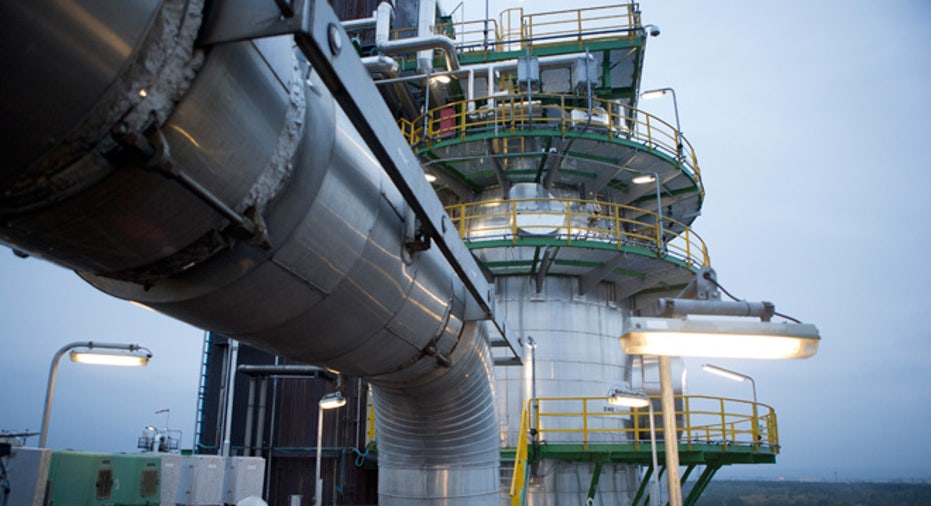Crude Drops as Inventory Builds Scare Market

U.S. oil prices made small gains in topsy-turvy trading that had briefly sent the market to nearly a six-year low Thursday.
Bottom-pickers and sellers concerned about oversupply battled for control of a market that has fallen about 60% in six months. Private data suggested that a glut of oil kept growing in recent days, triggering Thursday's selling, but that simply drew in the type of traders who keep waiting for oil to turnaround, traders said.
"They've beaten this market so into the ground that it's way overdue for a real serious correction," said Jeffrey Grossman, president of BRG Brokerage in New York. "Certainly for the near term, I don't see it as a market that is going to continue to fall away relentlessly."
Light, sweet crude for March delivery, the U.S. benchmark, settled up 8 cents, or 0.2%, at $44.53 a barrel on The New York Mercantile Exchange. The price had dropped to $43.58 a barrel by about 11 a.m., the lowest point since March 12, 2009.
The front-month March contract for Brent crude settled up 66 cents, or 1.4%, to $49.13 a barrel on London's ICE Futures exchange. The gap between Brent and WTI prices had closed less than two weeks ago, but Thursday it had spread to nearly $5 a barrel.
Both the U.S. and global benchmarks retreated after Genscape, an energy data service, told clients that stocks at a key Oklahoma storage hub grew 1.6 million barrels in just five days, from Jan. 23 to Jan. 27, two people familiar with the data said. The same hub had a 2.1 million-barrel increase last week, part of a rush of oil going into storage that sent national stockpiles to their highest point in at least 80 years, according to the U.S. Energy Information Administration.
Genscape acknowledged that the market moved after its report, but a spokeswoman declined to confirm exactly what the data said about the amount of oil stored in Cushing, Okla.
Some traders believe sellers still have command of the market with many producers looking to hedge and speculators seeking to bet on falling prices. While some inexperienced traders are trying to pick a bottom, veterans have repeatedly jumped in to sell on any rally, said Mark Waggoner, president of brokerage Excel Futures.
"Everyone I talked to who has been a trader for a long time wants to short this," he said. "It's obvious that we have tons and tons of oil."
U.S. production has surged as technologies such as horizontal drilling and hydraulic fracturing have unlocked new oil and gas reserves. Last week's U.S. oil output still grew 15% on an annual basis, despite low oil prices, Capital Economics said in a note.
The robust domestic supply hasn't stopped U.S. refiners from bringing in oil from abroad, however. The U.S. Energy Information Administration said Wednesday that imports rose by more than 200,000 barrels a day last week.
Global oil is so inexpensive now that using railroads to ship U.S. crude from the Bakken Shale field in North Dakota and Montana to the East Coast doesn't make sense, analysts have said. Refiners are bringing in more international oil, and that trend is likely to continue as low front-month prices encourage traders to store more oil on ships, Macquarie Group Ltd. said in a note Thursday.
"If the forward curve did not permit making money on a storage trade, that oil would be left in the ground," said Dominick Chirichella, an analyst at the Energy Management Institute. "The reason people are building inventories is because they're making money doing it."
The U.S. is going to have to act like the swing producer and cut supply to balance the oil market, Harold Hamm, chief executive of oil producer Continental Resources Inc., told The Wall Street Journal on Wednesday.
Some analysts have said U.S. production is likely to slow sooner than the market expects.
Norbert Rucker, head of commodity research at Julius Baer, said a flattening of U.S. output should be expected soon because drilling in the U.S. shale-oil industry has been "dropping like a stone" since December, and there is usually a four-month lag between this affecting production growth.
This would drive a rebound in prices but the "new normal" would be about $65 a barrel, a lower level than in recent years, Mr. Rucker said, citing advances in technology that have deflated production costs.
"We also know now there is a lot more oil in the ground," he said.
(Georgi Kantchev and Erin Ailworth contributed to this article.)